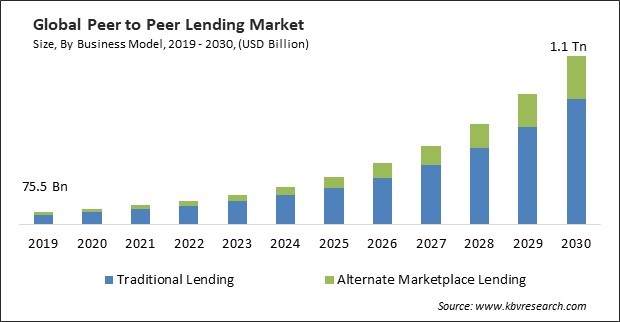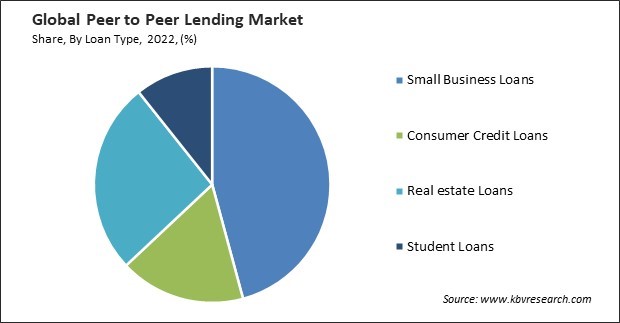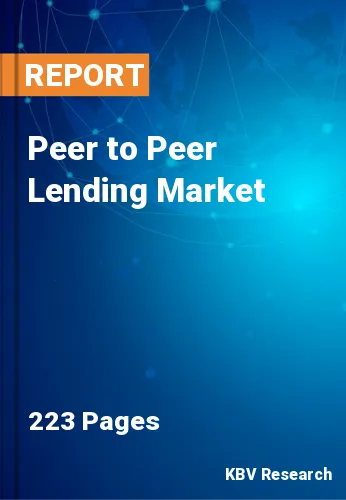The Global Peer to Peer Lending Market size is expected to reach $1.1 Trillion by 2030, rising at a market growth of 28.0% CAGR during the forecast period.
P2P lending platforms in Europe have played a vital role in expanding access to credit, especially for individuals and small businesses that traditional banks might have underserved. Thereby, the European region acquired $39,059.9 million revenue in the market in 2022. The inclusive nature of these platforms appeals to a wide range of borrowers. Europe's persistently low-interest rate environment has driven investors to seek higher returns outside of traditional savings accounts. P2P lending has emerged as an attractive option for investors looking to earn a more substantial yield on their funds. Some of the factors impacting the market are less operating cost and low market risk, improved efficiency and faster speed with peer to peer lending, and constantly evolving regulatory environment and compliances.

P2P lending platforms typically have lower operational costs than traditional banks and financial institutions. This cost advantage allows them to offer more competitive interest rates to borrowers. As a result, borrowers are attracted to these platforms to access lower-cost loans, reducing the overall financial burden of borrowing. Lower operational costs enable P2P platforms to pass on a significant portion of their cost savings to investors through higher returns. This attracts investors seeking better yields on their investments, especially in environments with historically low-interest rates on traditional savings and investment options. Platforms constantly strive to improve their offerings and differentiate themselves, resulting in a more dynamic and customer-focused market. Additionally, the swift loan approval and disbursement process allows borrowers to meet their financial needs without unnecessary delays. Borrowers can access funds on their terms and repay loans according to their schedules. P2P lending platforms offer a convenient online experience. Borrowers can submit applications and track their loans from the comfort of their homes, and investors can easily manage their investments. This convenience fosters positive user experiences, encouraging loyalty and continued usage. P2P lending platforms often promote transparency in their processes, clarifying how funds are allocated and what fees are involved. This transparency builds trust and confidence among users. Hence, these factors pose lucrative growth prospects for the market.
However, Frequent changes in regulations can disrupt the operations of P2P lending platforms. Compliance with new requirements may require significant adjustments to existing processes and systems, leading to operational challenges and potential downtime. Evolving and stringent regulations can be a significant entry barrier for new P2P lending platforms. The cost and complexity of compliance can deter startups and innovative companies from entering the market, reducing competition and potentially limiting market growth. Existing regulations may result in market saturation with a limited number of well-established P2P lending platforms that can afford to navigate complex regulatory requirements. This concentration can hinder market dynamism and innovation.
On the basis of the business model, the peer-to-peer lending market is divided into traditional lending and alternate marketplace lending. The traditional lending segment recorded the maximum revenue share in the peer-to-peer lending market in 2022. P2P lending platforms have diversified their loan offerings to include more traditional loan products. Initially, P2P lending platforms primarily focused on unsecured personal loans. However, as the market has matured, these platforms have expanded their product range to include secured loans, mortgages, auto loans, and small business loans. This expansion attracts borrowers more comfortable with traditional loan types and collateral-backed loans. As a result, these factors are expected to boost the demand in the traditional lending segment.
Based on loan type, the market is segmented into consumer credit loans, small business loans, student loans, and real estate loans. The consumer credit loans segment held a significant revenue share in the market in 2022. P2P lending platforms have incorporated advanced credit scoring models that utilize a wide range of data points to assess the creditworthiness of borrowers. Consequently, this leads to enhanced precision in evaluating risks and improved loan conditions for borrowers. Many P2P lending platforms offer flexible repayment options, including longer loan terms and customized repayment schedules, allowing borrowers to choose what works best for their financial situation. Owing to these benefits, there will be increased demand in the segment.

On the basis of end user, the market is bifurcated into business and personal. The business segment recorded the maximum revenue share in the market in 2022. P2P lending platforms offer SMEs and entrepreneurs an alternative source of capital, particularly for those with limited credit history or collateral, which may be challenging to acquire from traditional banks. This access to funding has fueled the growth of startups and small businesses, allowing them to expand, hire, and innovate. P2P lending platforms have expanded their offerings to cater to different business needs. These offerings include working capital loans, expansion loans, equipment financing, and more, allowing businesses to find tailored solutions for their specific requirements. These factors are expected to boost the demand in the segment.
| Report Attribute | Details |
|---|---|
| Market size value in 2022 | USD 149.4 Billion |
| Market size forecast in 2030 | USD 1.1 Trillion |
| Base Year | 2022 |
| Historical Period | 2019 to 2021 |
| Forecast Period | 2023 to 2030 |
| Revenue Growth Rate | CAGR of 28% from 2023 to 2030 |
| Number of Pages | 224 |
| Number of Table | 340 |
| Report coverage | Market Trends, Revenue Estimation and Forecast, Segmentation Analysis, Regional and Country Breakdown, Companies Strategic Developments, Company Profiling |
| Segments covered | Business Model, Loan Type, End User, Region |
| Country scope | US, Canada, Mexico, Germany, UK, France, Russia, Spain, Italy, China, Japan, India, South Korea, Singapore, Malaysia, Brazil, Argentina, UAE, Saudi Arabia, South Africa, Nigeria |
| Growth Drivers |
|
| Restraints |
|
By region, the market is segmented into North America, Europe, Asia Pacific, and LAMEA. The North America segment procured the highest revenue share in the market in 2022. In North America, there is a growing demand for alternative financing options. Many consumers, including individuals and small businesses, seek alternatives to traditional banks and credit unions due to competitive interest rates and faster loan approval processes offered by P2P platforms. North America has a robust fintech ecosystem, with a wide range of startups and technology-driven companies innovating in the financial sector. This ecosystem has supported the growth of P2P lending platforms. Therefore, there will be increased demand in the North America segment.
Free Valuable Insights: The Global Peer to Peer Lending Market size to reach USD 1.1 Trillion by 2030
The market research report covers the analysis of key stake holders of the market. Key companies profiled in the report include Harmoney Corp Limited, Funding Circle Limited (Funding Circle Holdings plc), LendingTree, LLC (LendingTree, Inc.), Upstart Network, Inc. (Upstart Holdings, Inc), LendingClub Bank (LendingClub Corporation), goPeer Corporation, Linked P2P Limited, Prosper Funding LLC (Prosper Marketplace, Inc.), Lending Loop (Loop Financial Inc.), and MoneyMe Limited.
By Business Model
By Loan Type
By End User
By Geography
This Market size is expected to reach $1.1 Trillion by 2030.
Lesser operating cost and low market risk are driving the Market in coming years, however, Constantly evolving regulatory environment and compliances restraints the growth of the Market.
Harmoney Corp Limited, Funding Circle Limited (Funding Circle Holdings plc), LendingTree, LLC (LendingTree, Inc.), Upstart Network, Inc. (Upstart Holdings, Inc), LendingClub Bank (LendingClub Corporation), goPeer Corporation, Linked P2P Limited, Prosper Funding LLC (Prosper Marketplace, Inc.), Lending Loop (Loop Financial Inc.), and MoneyMe Limited.
The expected CAGR of this Market is 28.0% from 2023 to 2030.
The Personal segment has shown the high growth rate of 29% during (2023 - 2030).
The North America region dominated the Market by Region in 2022, and would continue to be a dominant market till 2030; thereby, achieving a market value of $491.6 Billion by 2030, growing at a CAGR of 27.4 % during the forecast period.
Our team of dedicated experts can provide you with attractive expansion opportunities for your business.

